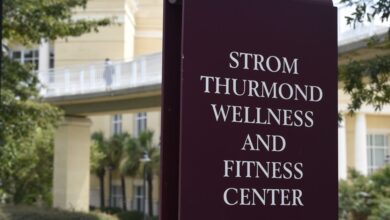The College That Mortgaged Everything

[ad_1]
Pinnow had a track record of developing new programs and finding new revenue, having spent more than a decade at Colorado Mesa University, where he was most recently senior vice president for strategic initiatives. He thought that made Finlandia a good fit. He also knew the campus, having been there when he was 16 and 17 for Lutheran summer teen-leadership camps, an influential time in his life.
When he arrived last summer, Pinnow discovered that the “balanced budget” the trustees had told him about presumed a 20-percent enrollment growth at a university that had been hemorrhaging students for decades.
Pinnow dug in, started putting together partnerships with other colleges, and laid the groundwork for a few new programs that could help stabilize the institution’s finances. If everything broke right, maybe this small private university in Michigan’s rural Upper Peninsula could keep going.

Aaron Peterson for The Chronicle
But the new ideas wouldn’t be paying off immediately. In the meantime, the university needed some cash to keep the doors open.
Pinnow had options. The university had a house with some land, a couple of vacant lots, and a big hospital-turned-office-building Pinnow could sell. He found buyers for the land and a couple of developers interested in purchasing the former hospital.
Then, just half a year into his first presidency, Pinnow got a strange call. Finlandia’s real-estate agent shared a piece of devastating news: All that stuff the university’s leaders wanted to sell wasn’t actually theirs to sell.
When I say it’s a mess, I can’t overstate it.
Patrick O’Keefe, Finlandia’s court-appointed receiver
Buried deep in county land records — and unknown to any current Finlandia administrators — were a series of encumbrances on pretty much the entire campus that had been signed in the 1990s in a successful effort to keep it afloat then. In other words, the university had already signed over almost everything as collateral for loans.
That snuffed out any hope of a resurrection. In March, the university announced it would close at the end of the academic year. As of the end of May, all the faculty and most of the staff had been laid off. Faculty who were on nine-month contracts being paid over 12 months were notified that while the university hoped to deliver the final six paychecks owed them, there were no guarantees it would be able to. Students who wanted to continue their studies were placed at a variety of colleges across the Midwest. Arrangements were made to store student records at other universities. The lone private college in Michigan’s Upper Peninsula no longer existed.
Now, an official appointed by a Michigan court is sorting through the rubble to see what can be sold off to finish paying faculty their salaries and repay a convoluted series of loans.
“When I say it’s a mess, I can’t overstate it,” said Patrick O’Keefe, the court-appointed receiver and a former trustee at Michigan State University. “The assets are cross-collateralized. It’s a hodgepodge of bad records and financial mismanagement.”
Pinnow, still working on campus during the university’s final days, still marvels at how the institution got to this point. “I’ve never seen anything like this,” he said. “It’s crazy.”
The cornerstone of the first building on campus, Old Main, was laid in 1898. The building still stands, one of the properties tied up in mortgages and encumbrances. By the 1980s, Suomi had settled into a niche as a small liberal-arts college offering associate degrees to its roughly 600 students. (It began offering four-year degrees in 1996 and changed its name to Finlandia University in 2000.)
But then came 1994. Enrollment plunged by 137 students, down to 405. The next year, the slide continued, with only 340 students on campus. Nearly three decades later, it’s unclear why.
Whatever the cause, the enrollment drop hurt finances, which were already being stressed, so much that the college was unable to make payments on four bonds from the federal Department of Education. The bonds, issued in 1963, 1969, 1988, and 1990, were most likely used to help finance buildings, officials said.
The college sought, and got, a three-year moratorium on principal payments, according to land documents on file with Houghton County.
In exchange, the college agreed to not enter into any financial agreement that would use any of its property or finances as security on another loan.
The next year, 1995, the college and the Department of Education modified that agreement, allowing members of the Board of Trustees to lend $1.5 million to the college to “provide the necessary cash to balance” the operating budget, documents show. In exchange for the loan, the unnamed board members wanted mortgages on “all real estate” of the college. It appears they received the mortgages although land records aren’t completely clear.
This wasn’t the end of the college’s deal-making with the Department of Education. In 1999, the college asked for another moratorium on repayments. It got the deferral and gave up a “first and superior” mortgage on several parcels of land.
The Chronicle contacted the Education Department with questions about the deals; a spokesman acknowledged the message but did not provide any answers.
As the competing claims stacked on top of each other, it became difficult if not impossible to determine who had dibs on what in the event of financial collapse. But that didn’t stop the university from making deals.
In 2001, the institution was placed on heightened monitoring by the Department of Education. It had to obtain a new bond worth $587,455, which it secured by once again putting up unnamed assets of the university as collateral, in order to keep receiving federal funds, including student-loan revenue, documents show.
Despite enrollment crawling upward in the 2000s, thanks in large part to Finlandia’s aggressive recruiting of athletes, the college’s financial difficulties continued.
Cash from the government wasn’t enough. Audited financial statements show that administrators and board members kept trying to keep the doors open by pumping in millions in loans. That included a private investor’s loan worth more than $3.8 million at 9-percent interest. The Mission Investment Fund of the Evangelical Lutheran Church in America had also extended Finlandia a $1-million line of credit, which would be paid off over the course of an academic year and then repeated the next year. This took place several times during the 2010s, financial documents show.
By 2016, a “substantial portion” of the college’s assets had been put up as collateral for operating loans, according to the university’s audited financial statements.
The board itself continued to lend the college money. In the fiscal year ending June 30, 2016, unnamed board members lent the university $650,000 at 5-percent interest. The previous year, the board members lent $880,000 to the college. Some years, a portion of board-member loans were paid off, according to documents. Some years, a portion of board-member loans were forgiven.
It’s common for university board members — especially at private colleges — to financially support the institution. But that almost always comes in the form of gifts. It’s rare for them to lend money to the institutions whose finances they oversee.
Rare, but not unprecedented. Ohio Valley University borrowed at least $6.5 million from current and former board members and officers in the decade ending in 2019, as well as from family members and related companies, a Chronicle analysis found.
Board members’ lending money is shoddy management, said Armand Alacbay, chief of staff and senior vice president for strategy for the American Council of Trustees and Alumni, who works with boards on governance issues.
“Self-dealing is a no-no, even if it is done in good faith,” he said. “It’s generally not a good idea to say, ‘If you look at the fine print, it’s OK.’ If you have to do that, you’ve missed the point. You can’t be a fiduciary if you don’t have independence.”

Aaron Peterson for The Chronicle
By the time it closed, Finlandia was down to only two loans from the federal government. But over two decades, the university had struggled to keep up with its payments. Financial statements for the fiscal year ending June 30, 2021, show the university missed payments to the Department of Education, meaning it still owed a total of $1.7 million. Interest on the loans had been accruing since 2003.
That meant the department could call in Finlandia’s loans at any time, or seize the land if the university couldn’t pay.
Finlandia’s institutional accreditor, the Higher Learning Commission, has been aware of the university’s financial difficulties since at least 2012, records show. The agency put Finlandia on notice several times and required additional monitoring of its finances.
But in 2021, it informed the university that it was “no longer at risk for noncompliance” and was removing it from notice. It said the university’s faculty and staff met the required competency standards. It also said the university “continues to meet with concerns” criteria that require it to have enough resources to support “its current education programs and its plans for maintaining and strengthening their quality in the future.”
The accreditor did not reply to requests for comment.
Records paint a bleak portrait of the debt amassed over the years. By the time it closed, Finlandia owed more than $10.6 million across 12 loans, plus $275,000 more for equipment.
Philip Johnson was president for much of that period. Hired as the campus’s pastor and assistant to the president in 2006 and then hired to lead the university in 2007, Johnson served until 2022, when the board, after a no-confidence vote from the faculty and other controversy, encouraged him to resign. Johnson did not respond to messages requesting comment.
The decision by Finlandia administrators and board members to effectively sign away the campus for short-term cash was a fatal error, O’Keefe, the official appointed to oversee the dissolution, said.
“They just kept throwing more money at it,” he said. “I blame the management for that.”
Boards, he added, “need to be serious” about dealing with projected enrollment dips. As more colleges face those looming declines, O’Keefe said, Finlandia “is just the tip of the iceberg.”
Michael Nakkula, Finlandia’s board chairman, declined to comment or answer questions about the university’s closure.
With millions of dollars owed, Pinnow’s only hope for salvation was the endowment. But that had been tapped out, leaving the president with no levers to pull.
Within days, Pinnow and the board reached the hard conclusion. The school was out of money and unable to get more.
“There were zero reserves,” he said. “There were none. Everything was fully leveraged.”
On March 2, the board announced Finlandia’s closure, blaming “an unbearable debt load.”
Pinnow presided over the breaking of the news with a heavy heart. “Trying to help these folks see the end had arrived was tough,” he said.

Aaron Peterson for The Chronicle
“I’ve had to make the worst decision a president can make,” he added. “I had 10 years of experience in 10 months. I’d make a good president now, but I’ll probably not get another one.” There aren’t many presidencies available for someone who’s closed a college.
“The renovations were always going to be completed next year,” she said during the ceremony.
People on campus had long been aware of the institution’s financial precarity. Faculty saw a series of reductions, including in 2020-21 when contributions to their retirement were taken away and pay cuts imposed: 5 percent for assistant professors and 10 percent for associates.
“This was absolutely a leadership failure,” Dekker told The Chronicle. “For years we had inexperienced leaders who made bad decisions. This year we finally assembled the people who could have made a difference, but they didn’t have the opportunity.”
Two days after the members of Finlandia’s final graduating class received their diplomas, a letter arrived in faculty and staff mailboxes that destroyed any misconceptions about how bleak the university’s finances were.
After a couple of paragraphs reminding the employees to be out of their offices by May 12, O’Keefe, the court-appointed receiver, cut right to the point: Finlandia didn’t have enough cash to finish paying what was owed to faculty members.
“We intend to compensate all staff for the work and benefits earned,” the letter from O’Keefe said. However, Finlandia was “insolvent” and any payouts for salary and vacation owed to employees would come only as the defunct university somehow got funds.
For most faculty, working on nine-month contracts being paid out over 12 months, that meant six paychecks would be missed, or maybe paid out somewhere down the line.
Then came the kicker: Please don’t sue us for those wages, O’Keefe wrote.
“While the University’s delayed payment may constitute a valid wage claim, if employees hire attorneys to pursue these claims it will only make the dissolution more expensive, leaving even fewer funds available to make employees whole,” he wrote. “Civil actions by employees could delay the payouts and reduce the total amount that the University can pay to employees. Please remember that even if various employees are able to obtain judgments ordering the University to pay further compensation, the cost of the litigation will have reduced the total amount of funds available to employees, and a judgment against an organization with no funds can’t be enforced.”
O’Keefe hopes he will be able to sell the land and buildings, but he knows it’s a tall task.
First, there’s no apparent market for the buildings or the land. Hancock is a town of just over 4,000. It is across the Keweenaw Waterway from Houghton, which is home to Michigan Technological University and has about 8,000 residents. Michigan Tech and Finlandia have been among the area’s top employers. There is no other dominant industry there.

Aaron Peterson for The Chronicle
And even if someone is interested, getting the property free of all of the encumbrances is going to be a struggle.
“This makes entering into purchase agreements problematic since many properties have debt that exceed their value and the lender’s interest is often cross collateralized with another non performing property,” O’Keefe wrote in an April 30 report to the court. “Almost all of the real estate has debt that exceeds value.”
Selling college buildings can be hard. Ohio Valley University’s entire campus was placed for sale in August 2022. Media reports showed that a letter of intent to buy had been signed in December 2022, but as of the end of May the property was still listed for sale. The campus includes 11 buildings containing more than 327,000 square feet on 255 acres.
There are continuing conversations with several developers for the Ohio Valley property, David E. Levy, managing director of Keen-Summit Capital Partners LLC told The Chronicle. Various nondisclosure agreements limited his ability to provide further details, he said.
No price is included in the listing.
It’s not just students and employees who are affected by Finlandia’s closure. At a recent Hancock City Planning Commission meeting, City Manager Mary Babcock said the town was worried that the government’s lien might remain on the land, in which case the receiver might himself be at an impasse, according to a media report of the meeting. “And this could all be left in the Department of Ed’s ownership.”
In Iowa, the campus of Iowa Wesleyan University, which also closed this spring, is now the property of the U.S. Department of Agriculture. The department had lent the private school $26 million in 2016, and the university couldn’t pay it off.
At Finlandia, an online auction to sell off items smaller than land parcels is underway. Savvy shoppers can find such items as an antique stand-alone safe, wooden picnic tables, and used football shoulder pads.
There are also multiple vehicles up for auction, including a 2018 Ford Fusion with 51,300 miles. But like most everything connected with Finlandia, it too has a lien on it that must be paid before the buyer can take the keys.
Dan Bauman contributed reporting for this article.
[ad_2]
Source link






